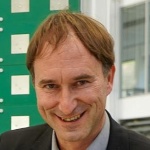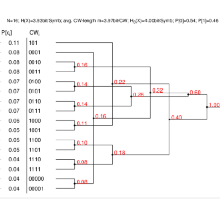Synopsis
This course teaches the basics of analog and digital communication systems with focus on the physical (bit transmission) layer. We follow bit vectors messages on their journey from a transmitter via a channel to a receiver, explaining modulation and detection, outlining the theoretical limits of source and channel coding, and discussing noise effects and capacity limits, to better understand the physical constraints of today's communication infrastructure, dominating our daily life.
Contents and Educational Objectives
1 Overview
1.1 Subjects covered by the Institute of Telecommunications
1.1.1 Bachelor degree
1.1.2 Master degree
2 Basics of Information Theory
2.1 Context of the course syllabus
2.2 A simple communication model
2.3 Information source
2.3.1 Probability of source symbols
2.3.2 Probabilities, events, joint events
2.3.3 Information content of a source
2.3.4 Redundancy of a source
2.3.5 Examples
2.4 Source coding
2.4.1 Codeword lengths
2.4.2 Prefix-free codewords, code-tree
2.4.3 Huffman code
2.5 Channel models
2.5.1 Discrete memoryless channel (DMC)
2.5.2 Some simple channel models
2.5.3 Illustration of joint and conditional probabilities
2.6 Channel capacity
2.6.1 Mutual information
2.6.2 Capacity
2.7 The additive white Gaussian noise channel
2.8 Channel coding
2.8.1 Overview
2.8.2 Principle of error detection and correction
2.8.3 Optimal decoding
2.8.4 Some examples of simple codes
2.8.5 Outlook
3 Modulation
3.1 Context of the course syllabus
3.2 Signals in Time and Frequency Domain
3.3 Amplitude Modulation (AM)
3.3.1 Time Domain
3.3.2 Transformation into the frequency domain
3.3.3 Frequency division multiplex
3.3.4 Coherent demodulation at the receiver
3.3.5 Non-coherent Demodulation
3.4 Quadrature Amplitude Modulation (QAM)
3.4.1 Starting-off from amplitude modulation (AM)
3.4.2 QAM-transmitter and coherent receiver
3.5 Digital QAM
3.5.1 Pulse shaping for symbol transmission
3.5.2 Constellation diagrams
3.5.3 Overview, bandwidth requirements
3.5.4 Achievable information rate over AWGN-channels
4 Transmission Lines
4.1 Context of course syllabus
4.2 Applications and cable geometries
4.3 Differential equation of transmission (telegraphy) lines
4.4 Solving the differential equation in the frequency domain
4.5 Special cases of transmission lines
4.5.1 Lossless transmission line
4.5.2 Transmission line at high frequency
4.6 Signals on transmission lines, time domain
4.6.1 Example, trapezoid-impuls at line input
4.6.2 Attentuation coefficient, in Neper or Dezibel?
4.7 A closer look at multiple reflections
4.7.1 Reflection factor
4.7.2 Time domain: Distance-time diagram
4.7.3 Frequency selectivity through multiple reflections
A Appendix
A.1 Transmission lines
A.1.1 Derivation of the telegraphers equation
A.1.2 Solving the differential equation in the frequency domain
A.2 Frequency modulation (FM)
A.2.1 Frequency modulation at the transmitter
A.2.2 Receiver for frequency modulation
A.3 Overview, Bessel function
A.4 Measurement: Rectangular versus Sin(x)/x-Impulses
B Webdemo-Problems
C Lecture, Seminar and Exam: Best Practices
C.1 Attending lectures
C.1.1 General
C.1.2 Lecture format
C.2 How to do well in exams
C.2.1 During the written exam
C.2.2 During the oral exam
Course Information
6 ECTS Credits
Lectures
| Lecturer | Prof. Dr.-Ing. Stephan ten Brink |
| Time Slot | Tuesday, 11:30-13:00 |
| Lecture Hall | V47/02/2.314 |
| Weekly Credit Hours | 2 |
Exercises
| Lecturer | Marcus Henninger |
| Time Slot | Wednesday, 11:30-13:00 (bi-weekly) |
| Lecture Hall | |
| Weekly Credit Hours | 1 |

Stephan ten Brink
Prof. Dr.-Ing.Director


